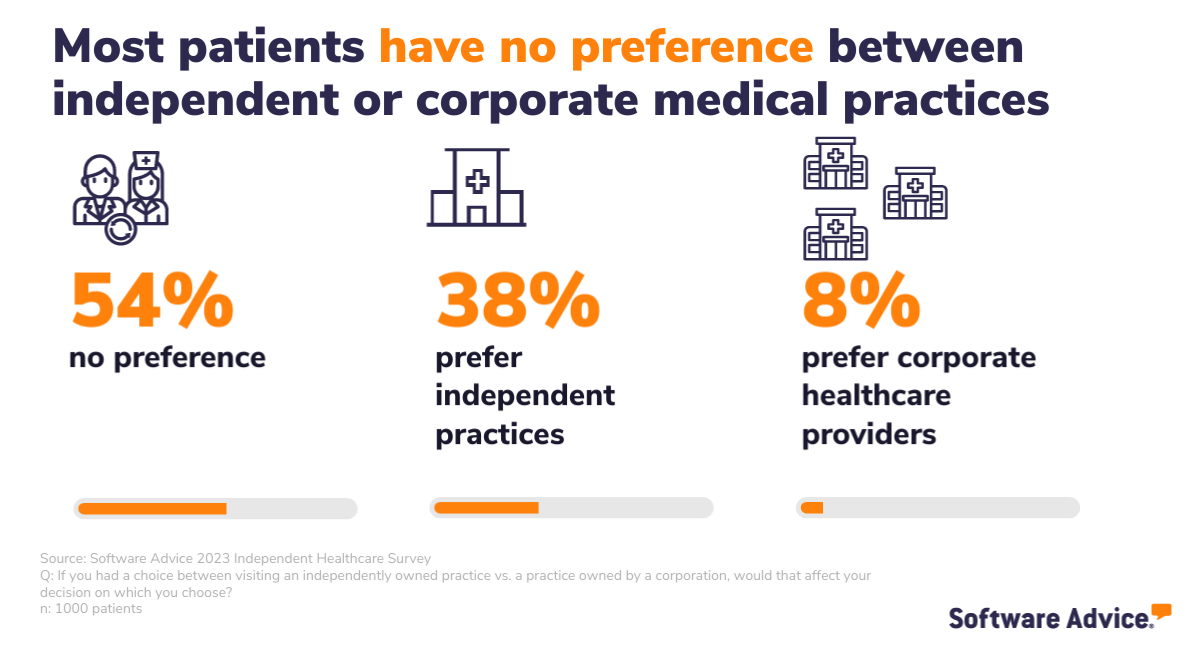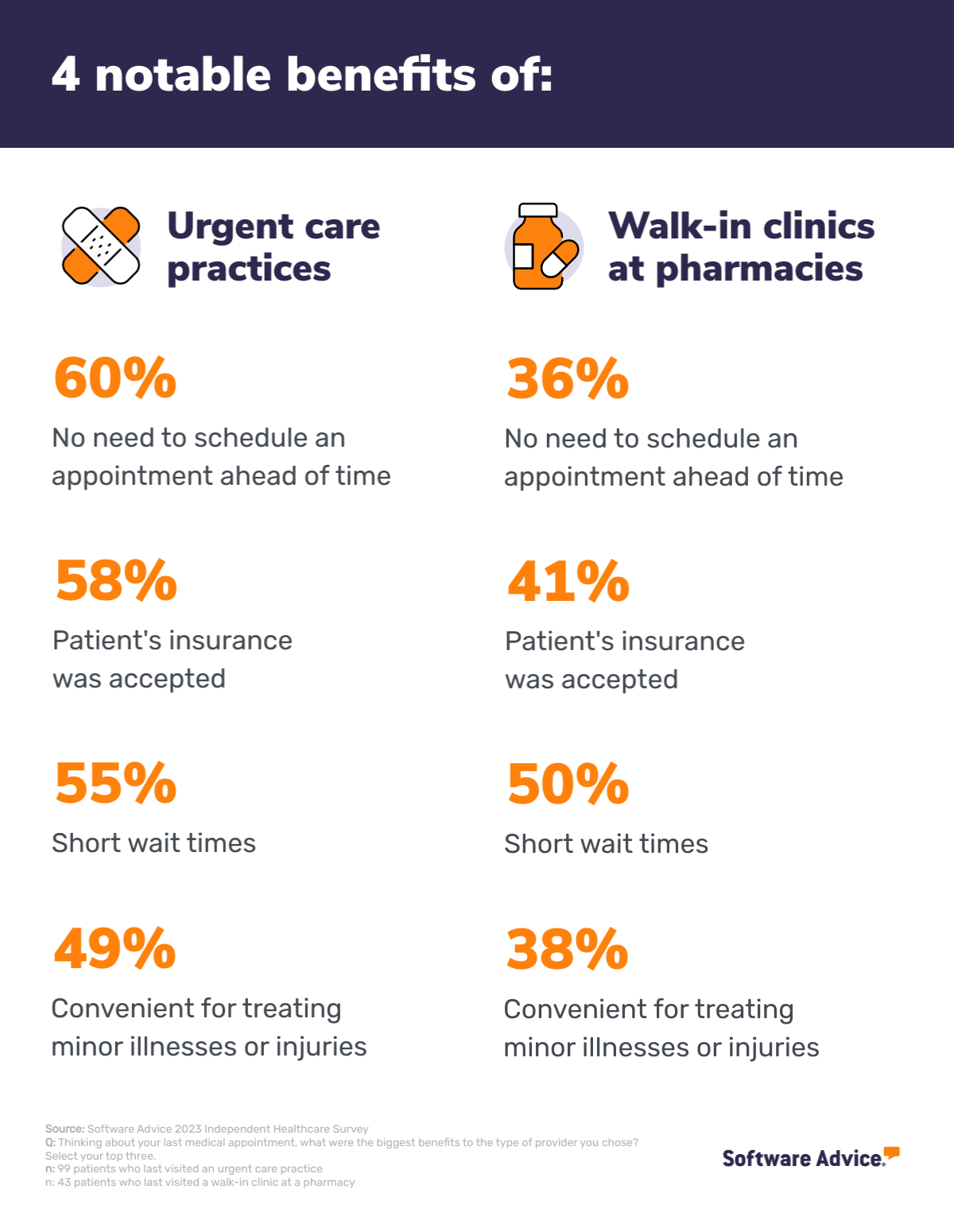Patients Want Fast Care from Corporate Practices, but Trust Independent Practices More
The shrinking number of primary care providers today is in large part caused by the number of independent practices and PCPs being bought out by major healthcare corporations and insurers. [1]
For primary care providers who want to maintain independence, competing with these corporate healthcare practices is essential. That means understanding—from a patient perspective—what these practices offer that most independent practices don't, and how you can bridge those gaps. It also means capitalizing on the unique benefits independent primary care doctors bring to their patients.
Our survey of 1,000 U.S. patients shows that while most don't have a preference between independently owned or corporate healthcare providers, they do appreciate the personal experience and higher quality of care privately owned practices offer.* But time savings and the convenience of corporate healthcare providers are still a huge draw.
Key findings
58% of patients are aware of who owns the practice they visit, and 54% have no preference between an independently owned or a corporate medical provider.
For patients who prefer independently owned providers, the doctor/patient relationship is key.
78% appreciate the more personal relationship with their provider
60% trust these providers more
57% say quality of care is higher
Patients say it’s easiest to get a diagnosis using telemedicine, and 61% say they were extremely satisfied with their last telemedicine exam.
Most patients aren’t swayed by practice ownership
An interesting place to start in understanding the patient perspective is by considering how much thought—if any—patients give to who owns the practice they're visiting. According to our survey, 58% of patients say they are aware whether the practice they visit is owned by a corporation or if it is independently operated.
When it comes to how much practice ownership affects patient preferences, we learned that over half of patients (54%) don't care whether they're visiting an independent or corporate medical practice.

Don't panic just yet though, because 38% of patients in our survey say they prefer to visit an independently owned practice, and only eight percent say they outright prefer to visit a corporate medical facility.
The good news
This data tells us that over a third of patients are already eager to seek out primary care providers at independently operated practices. It also tells us that you have an opportunity to sway 54% of patients if you apply smart marketing strategies that highlight the benefits patients can enjoy from an independent provider that they won't get from a corporate practice.
Now let's consider the pros and cons of each type of practice to determine precisely what those benefits are.
How independent providers and corporate healthcare match up
We asked patients what type of provider they visited for their last medical exam, and then we asked specific questions about their experiences with those providers.
The benefits of corporate healthcare
Among patients who last visited a walk-in clinic at a pharmacy or an urgent care practice, speed and low cost of care were the top benefits of visiting these types of providers.

We also asked patients who indicated a preference for corporate healthcare practices why they felt this way. The top responses had to do with speed:
66% say they can schedule appointments faster
51% say doctors respond faster
42% say exams are faster
It's clear from this data that faster healthcare is one of the biggest advantages these types of practices can offer patients. That's something that is generally expected from large, corporate healthcare organizations with broader infrastructures, more advanced technology on hand, and more employees.
From a patient perspective speed is key, and it also factors into affordability when you consider that most patients have to take time off of work to see a healthcare provider. We know from our survey that speed is not a particular strong suit when it comes to independently owned practices, but there are certainly other benefits that you can capitalize on when marketing your practice.
The benefits of independent healthcare
Fortunately, the benefits identified by patients who last visited an independent primary care provider are more substantive than the benefits of those who last saw a doctor at a corporate healthcare practice. Patients spoke to the higher quality of care and the more personal relationships with these providers, instead of merely highlighting convenience and speed of exams.
Among these patients, 81% say the biggest benefit of a primary care provider is that they accept the patient's insurance. Even more important, though, is the fact that 64% of patients say their independent primary care doctors provide a high quality of care, compared to only 26% who said this is true for walk-in clinics and only 19% for urgent care facilities.

We also asked patients how satisfied they were with their last medical exam. The patients who last saw independent primary care providers were the happiest, with 60% being “extremely satisfied” and another 36% being “somewhat satisfied.”
Finally, when we asked patients who stated a preference for independently owned providers why they felt that way, the results were telling:
78% say they have a more personal relationship with these providers
60% say they trust them more
58% say they prefer to support locally owned businesses
57% say the quality of care is higher
A word on telemedicine: Your secret weapon
Before we get to the strategies you can implement to better compete with corporate healthcare providers, let's talk about one of the most valuable tools available: telemedicine.
Among patients who last sought healthcare through telemedicine, 61% say they were extremely satisfied with the quality of care they received.
Additionally, 95% say obtaining a diagnosis was easy when they used telemedicine—making it the highest-rated option for ease of diagnosis in our survey. For many patients who want to get in, get treated, and get out as quickly as possible, being able to easily obtain a diagnosis is a huge factor in determining where they seek care.

If you aren’t already offering telemedicine appointments at your practice, you’re missing a massive opportunity to accommodate patients who need the speed and convenience of corporate healthcare, but also want the personal relationship an independent practice can provide.
Independent practices might be the underdog, but don’t count yourself out yet
While corporate healthcare practices have the advantage when it comes to seeing patients sooner and conducting speedy exams, independent primary care providers take the win in terms of earned trust and established relationships with patients.
There are certainly tools and marketing strategies that can help small practices move quicker, but it’s much harder for urgent care practices and walk-in clinics to achieve the same level of faith from their patients.
The final score
All of this tells us that independent practices actually do win out when it comes to the care they provide, but the challenge now becomes convincing those patients who are on the fence that establishing a relationship with your practice is the smarter decision for their short- and long-term health.
2 ways to compete with corporate practices
Knowing all that we know now about patient preferences, these concrete strategies can help you offer the same key benefits patients want from corporate healthcare as well as attract patients to your practice.
1. Close the gaps in timing and convenience through software
By strategically adopting the right software tools, you can speed up the entire patient experience at your practice. Using certain tools such as automated appointment scheduling, check-in, or intake systems can help patients get into your office and exam rooms a lot faster.
Another option is to invest in a good patient portal that allows you to communicate with patients much faster than traditional methods. Often, patients don’t take the time to schedule an appointment because they have a simple question that they want answered right away.
In these situations, patients can use the portal to send a direct message asking the question, and then you or someone on your team can quickly respond. As an added bonus, many practices are beginning to bill for these one-off communications, so providers can more easily justify spending their time messaging patients. [2] It’s a win all around.
And finally, telemedicine! If you aren’t already seeing some patients remotely, you’re losing. Patients enjoy the convenience and the speed of these phone and/or video conferencing tools, and it’s a huge factor that draws them to corporate providers in the first place.
2. Know your strengths and make sure potential patients know them, too
Once you’ve established a system and strategies to provide faster care, you’ll want to take a look at how you’re marketing your practice. We know that 42% of patients have no idea who owns the practice they visit, but 38% actively want to visit independent providers. That presents an opportunity for you to educate local patients through marketing.
Put it out there that you are an independent, locally owned practice. Make it known that you are a member of the local community, that your employees live in the area, and that patients who visit you are patronizing a small business instead of a faceless, corporate structure.
You can also capitalize on the fact that independent PCPs are able to offer something corporate practices can't: a personal relationship with your patients. That is, after all, your biggest advantage as an independent primary care provider.
To learn more on how to market your practice, check out these articles featuring advice from real doctors as well as concrete steps towards developing a marketing strategy and getting your name out there:
Sources
Corporate Giants Buy Up Primary Care Practices at Rapid Pace, New York Times
Why You Might Get Billed for Messaging Your Provider in MyChart, Verywell Health
Survey methodology
Software Advice's 2023 Independent Practice Survey was conducted in July 2023 among 1,000 patients in the U.S. who had visited a healthcare provider within the past two years. We polled these respondents to understand what types of providers they visited, what their experiences were like with these providers, and what their preferences and expectations are from healthcare providers in general.